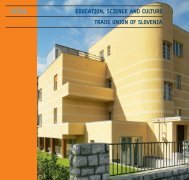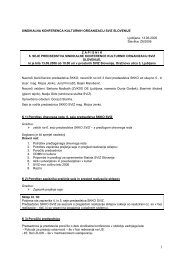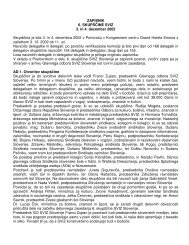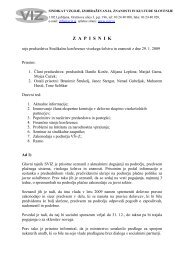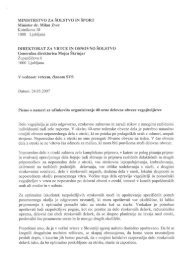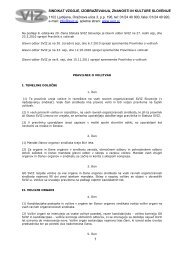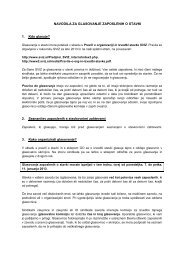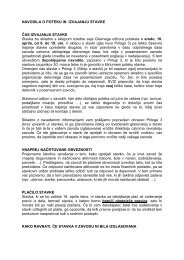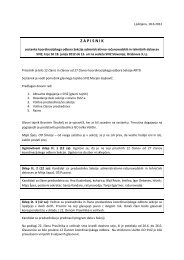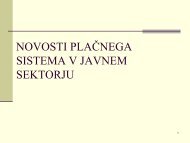Create successful ePaper yourself
Turn your PDF publications into a flip-book with our unique Google optimized e-Paper software.
V Piranu rojeni Giuseppe Tartini je bil eden izmed najbolj znanih violinistov<br />
in glasbenih teoretikov svojega časa. V njegovo violinsko šolo v<br />
Padovi so se zgrinjali učenci iz mnogih dežel Evrope. Kot skladatelj je bil<br />
predvsem mojster sonate, ki jo je nemalokrat preoblikoval v prizorišče<br />
virtuoznosti. Zlasti v komornih sonatah (da camera) se je oddaljil od ustaljene,<br />
iz suite izpeljane oblike. Njegova dela so sodobnike presenečala z<br />
izrazno močjo in afektiranostjo ter z drznimi harmonijami. Smisel glasbe<br />
za Tartinija namreč ni bil »preprost čutni užitek, temveč vznemirjenje,<br />
stopnjevanje ali pomiritev afektov s toni«.<br />
Slovita violinska sonata s <strong>program</strong>skim naslovom »Vražji trilček« je bila<br />
znana že pred letom 1750, izšla pa je posthumno (1798) v Parizu. Ime je<br />
dobila po sanjah, v katerih naj bi Tartini slišal hudiča igrati na violino; ko<br />
se je zbudil, je »vražjo« melodijo oz. trilček poskusil zapisati. Čeprav se<br />
vragov trilček pojavi šele v zadnjem stavku, je z »vražje« težkimi trilčki<br />
začinjena cela sonata. Začetni »Larghetto« v značilnem punktiranem ritmu<br />
in pastoralnemu vzdušju siciliana je le zatišje pred nevihto energičnega in<br />
bojevitega »Allegra«. Kratek počasni »Grave« uvaja zaključni in tehnično<br />
virtuozni »Allegro«, v katerem se sonata izkaže vredno svojega imena:<br />
vodilno melodijo spremljajo številni zadržki in trilčki na drugih strunah.<br />
Vmesni kratki počasni interludiji so le oddih in priprava na zaključno<br />
virtuoznost solistične kadence, kjer kult virtuoznosti že napoveduje kult<br />
virtuoza, s katerim bo čez nekaj desetletij ovenčan Paganini.<br />
Not a great deal is known about the composer, organist and organ maker<br />
Isaac Posch. He was born in Krems, Austria, and attended a Protestant school<br />
in Regensburg, where he obtained his music education. In 1614, he became<br />
an organist in Klagenfurt, most likely also working amongst the Protestant<br />
aristocracy. Between 1607 in 1640, he lived temporarily in Kranj. The first of his<br />
two best known instrumental collections, Musicalische Ehrenfreudt (1618), is<br />
dedicated to the Provincial Estates of Carniola; in 1621 it was followed by the<br />
collection Musicalische Tafelfreudt. The collections primarily contain dance<br />
movements in the northern German or even English instrumental style and<br />
represent an important contribution to the early baroque ‘variation’ suite.<br />
The opening four compositions of the first collection – “ballettas” – were<br />
intended for the entertainment of the aristocracy at mealtime. These are<br />
followed by three-movement suites, which could either accompany a meal<br />
or be used for dancing.<br />
PROGRAM / PROGRAM<br />
Amongst Antonio Vivaldi’s 500 concertos there are as many as 39 for bassoon,<br />
second in number only to the violin concertos. They were most likely<br />
written for performance in the Venetian institute for orphan girls, Ospedale<br />
della Pietà, which boasted musical activities of an enviable richness and<br />
where Vivaldi was employed; according to his contract with the Ospedale<br />
dating from 1723, Vivaldi was obliged to compose two new concertos each<br />
81



